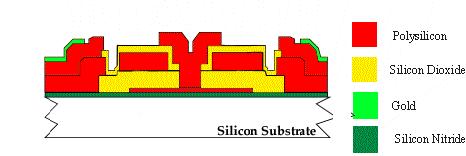EE290g: Homework #3: Due in class Tuesday, 9/16/97
This document is available on the web at www-inst.eecs.berkeley.edu/~ee290g/hw3.html
1. MEMS Cross Sections
a) Figure 1 shows the cross section of a micromachined cantilever.
What process was required to generate this device? Be sure to indicate
all depositions, lithography steps (i.e. patterns), and etches. Sketch
a cross section of each mask used.
b) Do the same for the cross section shown in Figure 2.
 Figure 1.
Figure 1.
|

Figure 2. |
2. CMOS Cross Sections
Figure 2 shows a (very) simplified cross section from a modern CMOS
process, like that used to make the Pentium Pro microprocessor. You should
notice the multiple layers of Aluminum interconnect that enables the large
amount of complex wiring necessary for modern microprocessors. For the
cross section shown in Figure 2, answer the following questions:
a) What depositions, lithography steps, and etches are required?
b) Assuming that the polysilicon resistivity is 1 Ohm * cm and that
the chip is 1 cm2, what is the highest resistance path
we can fabricate using a 2 um process (i.e. minimum line width of 2 um
and minimum line spacing of 2 um)?
c) What is the lowest resistance line we can make from one edge
of the chip to the other edge?
 Figure 3.
Figure 3.
3. Xenon Diflouride Etching
XeF2 is a silicon etch that does not appreciably etch SiO2
or Al. It can be used as a post-process etch to make silicon a sacrificial
layer for CMOS micromachining. We are planning on etching a 1 cm2
chip at 10 um per minute, but we know the reaction is strongly exothermic
and we are concerned that the chip will get too hot. The etching reaction
is:
2 XeF2(g) + Si(s) -> 2 Xe(g) + SiF4(g) + 22 eV
Assume that half of the energy generated escapes with the Xe gas.
a) What is the rate of heat generation (in Watts)?
b) If the chip is sitting on an ideal heat conductor (as shown in Figure
4a) what will the temperature be on the surface of the chip?
c) If the chip is sitting on a poor heat conductor, like a 2 mm thick
pyrex beaker (as shown in Figure 4b) what will the temperature be on the
surface of the chip?

Figure 4a |

Figure 4b
|
Assume that the metal counter is a perfect heat conductor at 25°C,
and that heat flow through the chip and the pyrex is one-dimensional.
4. Strength of Silicon
a) If you want to make a solid thread of silicon that will hold up
your body weight how large must the cross-sectional area be?
b) If the thread is round, what is the diameter?
c) What is the longest thread of this cross-sectional area that could
be made from a 1 cm2 chip that is 0.5 mm thick?
d) From 1 liter?
5. Strength of Spider's Silk
Imagine a spider that is about 1 cc in volume (a big one).
a) If the spider is the same density as water, and the spider's silk
thread has a Young's modulus of 50 GPa and a strain limit of 20% what diameter
of thread is necessary to support the weight of the spider?
b) If 1% of the spider's body is filled with silk, what is the longest
thread that can be made from the silk to support the spider?
c) From 1 liter?
Send comments to rconant@bsac.eecs.berkeley.edu